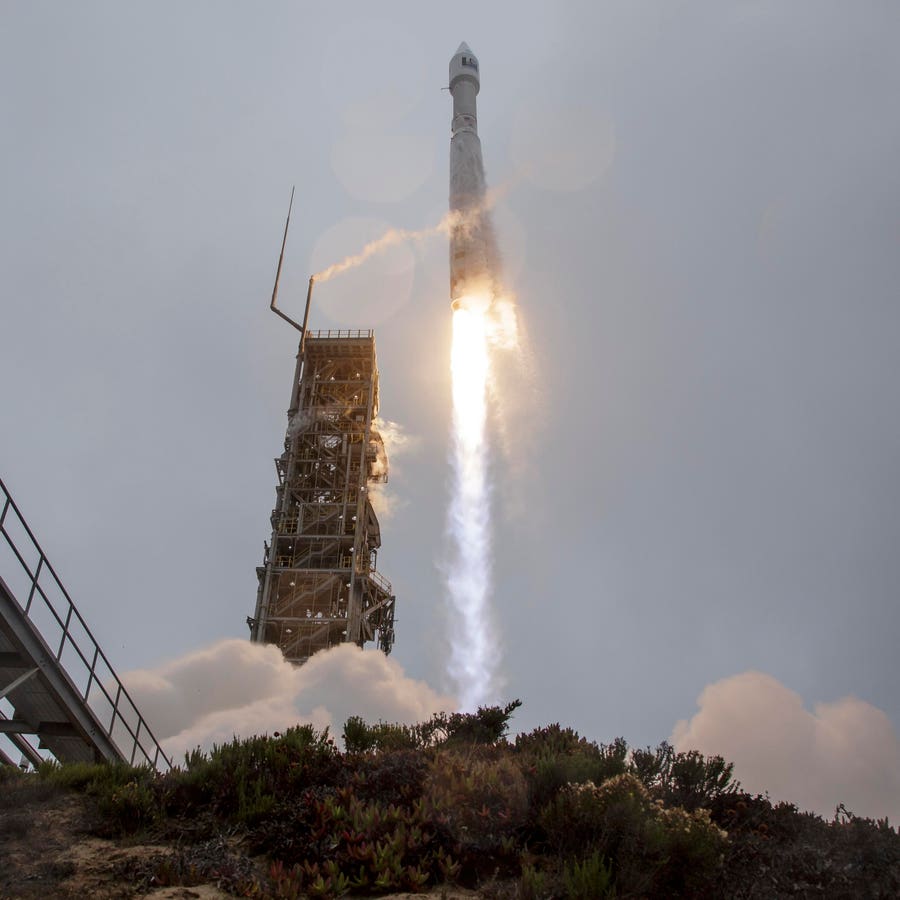A United Launch Alliance Atlas V rocket launches from Vandenberg Space Force Base.
America is struggling to keep up with a booming space industry. A particular space challenge is looming in the Pacific, where investments to bolster U.S. space launch infrastructure lag behind Florida’s highly-integrated East Coast launch complexes. This East Coast overweighting is a mistake. Too much big-booster production and other key space manufacturing infrastructure is consolidating eastward. But America’s Western launch sites are growing in importance, and the lack of space industry investment may strangle opportunities for future growth.
The problem is an economic one. The space industry loves the short-term economic stimulus provided by the Southeastern states, but the operational consequences from the over-consolidation of this industry in the Southeast is, for certain space products, quite dire. Take boosters. The wide, tall and heavy rocket boosters of tomorrow are outgrowing America’s old-school roads and rail systems. They don’t travel well, and that forces America’s next-generation orbital rockets into a crippling dependence upon America’s fragile, underdeveloped and easily-disrupted maritime transportation network.
This, coupled with America’s unfortunate defenestration of the West Coast’s limited supply of industrial waterfront, means that America’s space launch industry is on the verge of trapping itself on the wrong side of the increasingly unreliable Panama Canal.
For the U.S. space economy, overbuilding East Coast space launch support infrastructure provides short term gains in exchange for long-term risks.
Cape Canaveral is a wonderful facility. But the Pacific offers America and the Space Industry massive and overlooked opportunities. Outside of SpaceX, America’s big-booster community has been slow to invest in the West Coast. To grow—and to challenge SpaceX’s virtual lock on the West Coast’s big-rocket opportunities, California’s Vandenberg Space Force Base, Alaska’s Pacific Spaceport Complex and other remote-but-ideally-placed launch sites in America’s Pacific territories need more West Coast-based booster production and associated support infrastructure.
A 212-foot-tall SLS core stage for the Artemis II moon rocket squeezes out of a barge
West Coast is the Space Industry’s Future:
For space flight, western momentum is undeniable. At California’s Vandenberg Space Force Base, the Falcon 9-driven launch tempo has increased by a torrid 30% a year. After hosting just four launches in 2012, Vandenberg is challenging Cape Canaveral’s blistering launch tempo. Between May 31 and June 28, Vandenberg hosted seven rocket launches to Cape Canaveral’s 10. It would only take a strong hurricane for Vandenberg to sneak ahead.
Farther north, the remote Pacific Spaceport Complex—becalmed by launch and testing failures—still predicts launch tempo at the Kodiak, Alaska-based facility will, by 2030, increase almost ten-fold.
Farther west, additional development beckons the right innovators. Long-abandoned U.S. rocket-launch facilities on Johnston Island, leased facilities on Kwajalein, and other remote places in the deep Pacific offer American space launch programs invaluable launching points near the equator. With open sea to the east, America’s island holdings may offer new frontiers for the big and heavy rockets—and the big, heavy payloads—of the future.
Right now, the only big-rocket company poised to exploit America’s Pacific space launch facilities is SpaceX. Elon Musk—a newly-minted presidential adversary—moved the SpaceX headquarters out of California in a highly-publicized political huff. Despite the well-orchestrated political showmanship, SpaceX has steadily expanded their West Coast footprint, growing a Long Beach port facility—just 30 minutes from a Falcon 9 first stage fabrication plant—so SpaceX employees can recover and refurbish Falcon 9 booster cores faster and, potentially, assemble and ship larger rockets for use elsewhere.
Rivals may be hesitant to challenge SpaceX in the Pacific, but, even SpaceX’s ideally-built-out 14-acre waterfront facility is no sure thing. Musk’s new “spaceport” is a former Navy base. In essence, SpaceX has effectively appropriated the Long Beach Naval Complex—and all the infrastructure investment the U.S. government made in the facility—for a bargain-basement cost. An irked White House could easily use the burgeoning national security threat in the Pacific as an excuse to recover the entire complex, dashing SpaceX’s virtual monopoly on America’s Pacific launch infrastructure—a step that would launch a healthy competition as booster manufacturers jostled for a West Coast toehold.
Even without White House involvement, additional big booster-building outposts outside of the already-crowded Los Angeles/Long Beach waterfront makes sense. Private industry is paying a lot for launches, offering an opportunity to quickly pay off the capital costs. Space, however, is limited. Only a handful of California harbors can offer the Space industry the right combination of waterfront access and skilled labor within a few hundred miles of Vandenberg’s launch pads.
Wider geographical distribution of America’s booster production and refurbishment sites is a good thing for America’s space industry. It is the only way to accelerate an already blistering Pacific launch tempo at Vandenberg, and America’s booster rockets, orbital payloads and geospatial stakes are just getting bigger.




